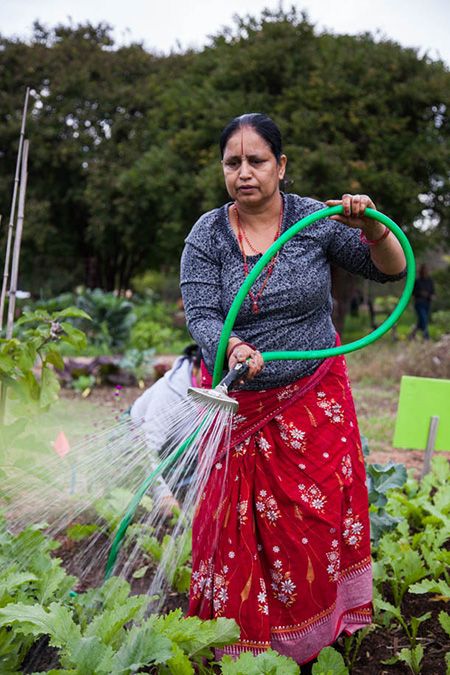Here in Central Texas, we have two seasons: hot and not. Gardening in a hot, semi-arid region that has extended dry periods punctuated by heavy rain makes it hard to consistently provide plants with the water they need to grow. Most food growers rely on tap water to keep their plants alive during dry weather, but gardeners are discovering that chemicals in tap water harm the soil organisms that plants depend upon to absorb nutrients. As a result, more and more gardeners are storing rainwater.
The most popular place to store rainwater is in tanks that collect rain off roofs, but rain can also be stored in the earth by constructing rain gardens. Developed to improve the quality of urban waterways by capturing and cleaning polluted run-off, rain gardens sit a few inches or feet below the surrounding landscape. They mimic the earth’s naturally uneven terrain, creating depressions where water can settle into the ground and where plant roots and soil organisms can rid the water of metals, salt, oils, and other contaminants. Because most rain gardens capture polluted water, they are planted with non-edible natives that grow along wetlands. Food growers can nonetheless benefit from the principal of rain gardens by planting sunken food gardens that capture rain from nearby roofs and adjacent paths and lawns. As long as rain does not run off large, paved areas, chemical-laden lawns, or roofs made of lead or treated wood, it is safe to use on vegetable gardens.
Read on for a how-to for creating successful sunken food gardens:
- Create a plan. How does the rain flow over your site? Are there already natural depressions? How much rain runs off? Do you want to capture some or all of it? Perhaps you'll decide to create a series of small rain gardens overtime so that every drop of water stays on your site. Whatever you do, start small and build your gardens at least 10 feet from building foundations. Rain gardens can take any shape so be creative and have fun.
- Call 811 to have your utilities marked before you start digging.
- Dig. You want your sunken garden to be at least 3 inches below the surrounding terrain. If you’re working with existing natural depressions, you may only need to loosen and amend your soil. If you’re working on a slope, you may need to build swales. These are long mounds of dirt that run perpendicular to the slope, stopping run off so that it percolates into the soil. You may need to excavate soil in order to sink your garden. Alternatively, you can sink your garden by building up your paths with woodchips. Whatever option you chose, make sure your soil is loose and drains well. This means that if you are working with Blackland Prairie clay, you will need to add sand and compost. Also, make sure the bottom of your garden is flat so that water infiltrates evenly and does not pool.
- Mulch. This adds another layer of material to hold water, and it prevents heavy rain from disturbing the soil. If you are catching rain directly off a roof, build a splash pad of gravel or stone so that the rain does not create a canyon in your garden bed.
- Plant. If you have a shallow rain garden that captures small amounts of run-off, you can plant the usual suspects, such as spinach, onion and carrots. If you’re collecting a moderate amount of run-off, you can plant vegetables like tomatoes, arugula, peas and brassicas. If your garden captures a lot of water, use plants that can handle both heavily saturated and dry soil. Some of these plants include chile piquin, watercress, currants and most berries. With a little experimentation and practice, you will have a food garden that requires less hand watering than a level or raised garden and which thrives even during Texas’ hot, dry summers.
Remember, depending on what you plant and how much water you capture, you may still need to water your plants between rain events, but if your sunken gardens are properly constructed, you will need to water much less often.
For more information on rain gardens and on other techniques for storing water in the ground, we recommend reading Rainwater Harvesting for Drylands and Beyond, by Brad Lancaster. You can also visit Grow Green’s online resource for rain gardens as well as the Austin Watershed Department’s online resources. If you're interested in an interactive, hands-on introduction to rain gardens, join us in the SFC Teaching Garden on Saturday, October18th, from 10am-12:30pm, where we will learn about and build a rain garden. Get more info and register here.

